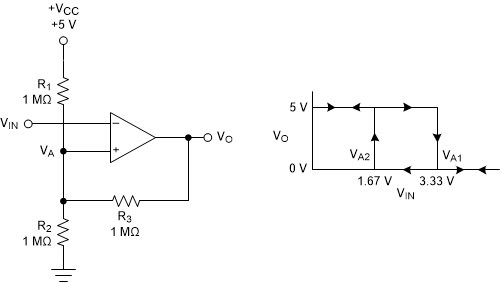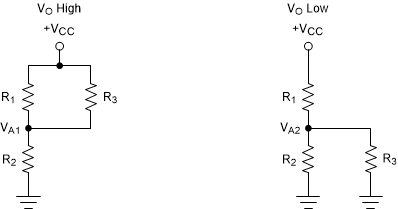SNOSDK2A June 2024 – December 2024 TLV3231-Q1
PRODMIX
- 1
- 1 Features
- 2 Applications
- 3 Description
- 4 Pin Configuration and Functions
- 5 Specifications
- 6 Detailed Description
- 7 Application and Implementation
- 8 Device and Documentation Support
- 9 Revision History
- 10Mechanical, Packaging, and Orderable Information
7.1.2.1 Inverting Comparator With Hysteresis
The inverting comparator with hysteresis requires a three-resistor network that is referenced to the comparator supply voltage (VCC), as shown in Figure 7-3.
 Figure 7-3 TLV3231-Q1 in an Inverting Configuration With Hysteresis
Figure 7-3 TLV3231-Q1 in an Inverting Configuration With HysteresisThe equivalent resistor networks when the output is high and low are shown in Figure 7-3.
 Figure 7-4 Inverting Configuration Resistor Equivalent Networks
Figure 7-4 Inverting Configuration Resistor Equivalent NetworksWhen VIN is less than VA, the output voltage is high (for simplicity, assume VO switches as high as VCC). The three network resistors can be represented as R1 || R3 in series with R2, as shown in Figure 7-4.
Equation 1 below defines the high-to-low trip voltage (VA1).

When VIN is greater than VA, the output voltage is low. In this case, the three network resistors can be presented as R2 || R3 in series with R1, as shown in Equation 2.
Use Equation 2 to define the low to high trip voltage (VA2).

Equation 3 defines the total hysteresis provided by the network.
